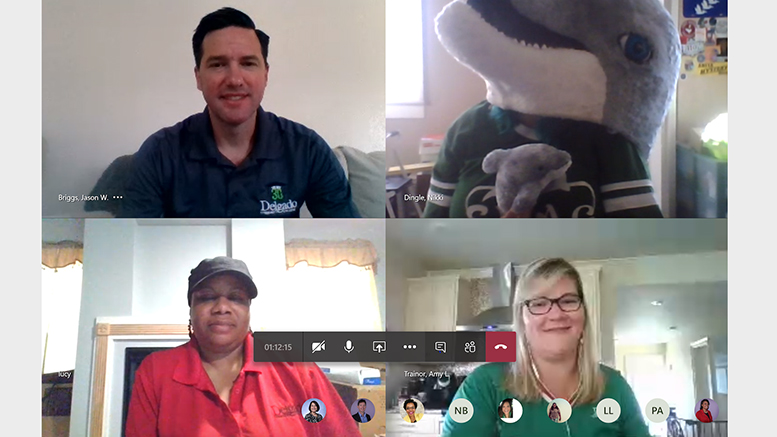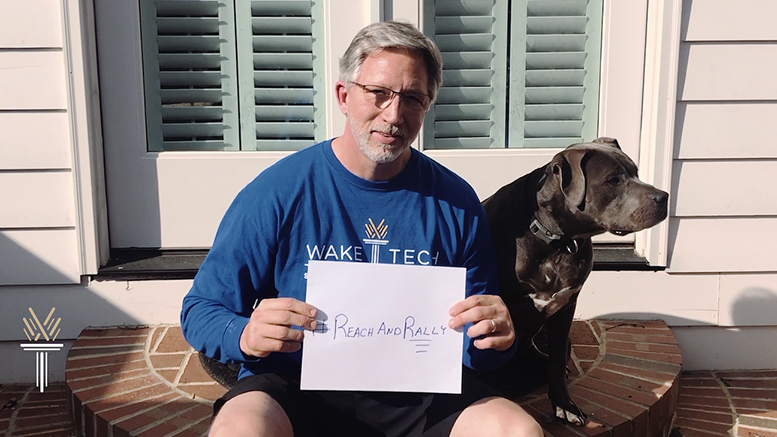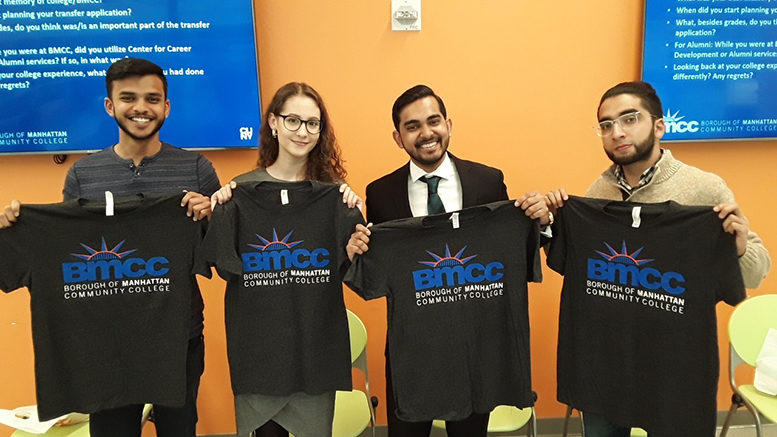As community college recruiting tools – such as open houses, campus tours and college fairs – have gone digital during the coronavirus crisis, enrollment professionals say it’s more important than ever to forge personal connections with students.
When the Borough of Manhattan Community College (BMCC) in New York City invited students to an upcoming virtual open house, “we let them know their safety and health is the most important thing,” says Joshua Perez, BMCC’s admissions recruitment coordinator.
Because so many students lost a job or have a family member or friend with COVID-19, the main message from BMCC is that “staff is here to help them and ease their anxiety,” Perez says. “We’re trying to give a possible ray of light,” through assistance and even financial help, such as emergency grants.
College staff is urged to “show empathy with every conversation we have, even if it’s a transactional call asking them to send their transcript,” he says. “It’s about constantly throwing off positive energy, not just checking off a box.”
Obstacles = opportunities
“Generation Z likes a face and likes to make a connection with that face,” Perez says, so “we’re making ourselves visible” by posting the faces of key administrators along with their emails and a line about their hobbies on BMCC’s enrollment page.
It took just a single weekend to transform BMCC’s call center to a virtual center with staff working at home. The college’s new Live Help knowledge tool, accessible on a phone or computer 24/7, lets students write a question and receive articles based on their keywords.
The CUNY Explorers Program, which brings middle school students to campus to spark their interest in going to college, has gone digital, too. BMCC is hosting Instagram Live sessions for middle school students, with fun themes, such a pajama party.
Once things return to normal, the digital systems put in place “will make us stronger,” says Diane Walleser, vice president for enrollment management at BMCC. “It’s forced us to become creative and agile in our planning and delivery of services. We’ve taken a lot of obstacles and converted them to opportunities.”
Targeting the unemployed
At Delgado Community College (DCC) in Louisiana, “we’re trying to brainstorm as many things as possible” to reach students remotely, says Michele Greco, director of enrollment management.
DCC’s Community College Week, an on-campus recruitment event, was moved to Facebook Live, with a virtual open house and a welcome video from each campus.
Delgado is using the Microsoft Teams app to invite students to one-on-one virtual financial aid sessions in partnership with Southeastern Louisiana University. To reach students without a computer or wifi, DCC invites them via Facebook Live to use an 800 number to access a call center for one-on-one assistance.
So far, 1,500 students have registered for the summer session.
“That’s on track with what we expected,” Greco says, but it’s hard to predict whether enrollment will stay strong as registration opened earlier than usual. Fall registration started a little earlier, too, and so far, it’s about 100 students below normal.

DCC also will hold its first “Maymester,” a 14-day intersession in May to give students an opportunity to earn college credits in a compressed, online format on the Canvas platform. This session could be particularly helpful for the many laid-off hospitality workers in New Orleans who might want to consider a new career in the city’s growing cloud computing industry, Greco says.
“We’re stressing short-term training opportunities for those workers, as no one knows when tourism will come back,” she says.
To draw people to the Maymester and two new mini-mester sessions in the summer, the college is using TV and radio ads more than it usually does, and reaching out to industry groups representing restaurant and hotel owners, Greco says.
Pipeline for high schools
To reach high school students during the shutdown, Delgado is participating in a virtual state college fair and connecting with high school counselors individually. The college’s orientation session will be an interactive webinar.
DCC also has expanded its use of live chat to 12 hours a day, using the tawk.to platform, which directs students to the right staff person. Delgado was already going in this direction over the past six months. The pandemic has fast-tracked projects in the pipeline, Greco says.
One of these projects is a new mental health app called WellTrack, which offers interactive self-help guidance for students.
“We’re showing students we support them holistically,” Greco says. “We’re in this with you.”
Reaching students via phones
Recruiters at Central Piedmont Community College (CPCC) in North Carolina are using Google Voice and texts to invite students to enroll in the summer and fall semesters.
“Since students are home, they’re actually answering the phone. They’re actually using their iPhone as a phone now,” says JJ McEachern, dean of enrollment management. “Recruiters are having great conversations with them.”
CPCC has also increased its use of postcards and other direct mail, as people stuck at home are “at least looking at mail a bit more now,” he says. One target of those campaigns is four-year college students who might want to continue their education closer to home.
“Community college students aren’t actively recruited by other colleges because we’re open admission,” McEachern says. A mailing sent to their home inviting them to apply “makes them feel like they’re being recruited.”
CPCC is creating video campus tours and setting up Zoom meetings with prospective students, while student ambassadors – who used to conduct live campus tours – are using tools such as Instagram Live, WebX, Google Hangouts and Facebook Live to reach potential applicants.
In a public setting, students may not speak up, McEachern says, but they’re more likely to ask questions in a chatbox.
Virtual college fairs
“Normally at this time of year, we’re attending a variety of college fairs and engaging with high schools,” says Terisita Rodriquez, vice president of enrollment development at Santa Monica College (SMC) in California.
When the college and high schools closed, “we’ve had to pivot,” Rodriguez says. SMC’s annual Senior Experiences event was canceled, so college staff reached out to high school seniors in a variety of ways, including live chats and webinars.
All student services have transferred to remote platforms, including PeopleGrove, for connecting students with counselors.
In the past, Rodriguez found that online recruitment fairs yielded little for the college. But it’s an option that’s back on the table. “Now we’re looking at doing that again,” she says.
A significant student population for the colleges that’s likely to drop is international students, Rodriguez says. Students from China who left this winter aren’t coming back, she says, and “we’ve seen huge declines in applications from international students.”
Retaining students
Retaining current students is crucial, as colleges are losing 20 percent to 40 percent of their students due to the transition to online learning during the pandemic, and that’s especially true for technical schools focusing on hands-on programs, says Kathi Swanson, president of CLARUS Corp., a marketing firm.
If that carries over into the fall, “we’re looking at a very dire number,” Swanson said in a webinar sponsored by the National Council for Marketing and Public Relations, a group affiliated with the American Association of Community Colleges.
Swanson encourages colleges to make a big push for summer enrollment.
“National research indicates if we get a student to enroll in the summer, they’re five times more likely to enroll in the fall,” she says.
She suggests using geofencing to target messages in a particular geographic area to reach potential students who might be at home with their parents. For students, the message should be, “Don’t let COVID-19 interrupt your education,” while parents should be advised to help keep their child on track.
Because high school seniors are losing out on the milestones of senior year, such as graduation and prom, Swanson says, the message to them should be positive, congratulating them on their accomplishments.
For adults, ads should be based on the target group’s age, educational level and employment stability, she advises. For adults who were laid off, for example, the message should focus on getting skills for a new, better job and should emphasize the availability of student aid.
A personal connection
The first message to current students should be “We’ve got your back,” Swanson says. That offers support for students and pushes against the isolation that many of them now feel.
That’s the message in a simple video by Wake Technical Community College in North Carolina, featuring college administrators, including President Scott Ralls, holding up homemade signs with such statements as “No matter the challenge, your Wake Tech family is here for you every step of the way.”
“That video was a way to reach out to current students to let them know our campuses are closed but our college is not,” Ralls says. “We want to make sure they know everyone on campus is still engaged.”

Wake Tech teams – based at the counseling center, wellness center and library, for example – have been “extremely aggressive in reaching out,” Ralls says.
So far, college representatives have made phone calls or emails to about 10,000 of the 23,000 students enrolled this semester. Their top priority is to engage students who had not yet taken advantage of online learning. Staff have asked students about their life challenges, as well as academic issues, and offered grocery gift cards and other resources.
The impact on enrollment won’t be known for a while, Ralls says, but “we have not seen as many student withdrawals as might have been expected at this point.” He worries about the future, however, as many Wake Tech students have lost jobs they depended on to pay for college.
“Community colleges are obviously unique. The word ‘community’ is in our name,” Ralls says. “Community colleges really shine in these moments because we are connected to our communities, and we see how our faculty and staff really care about our students.”

